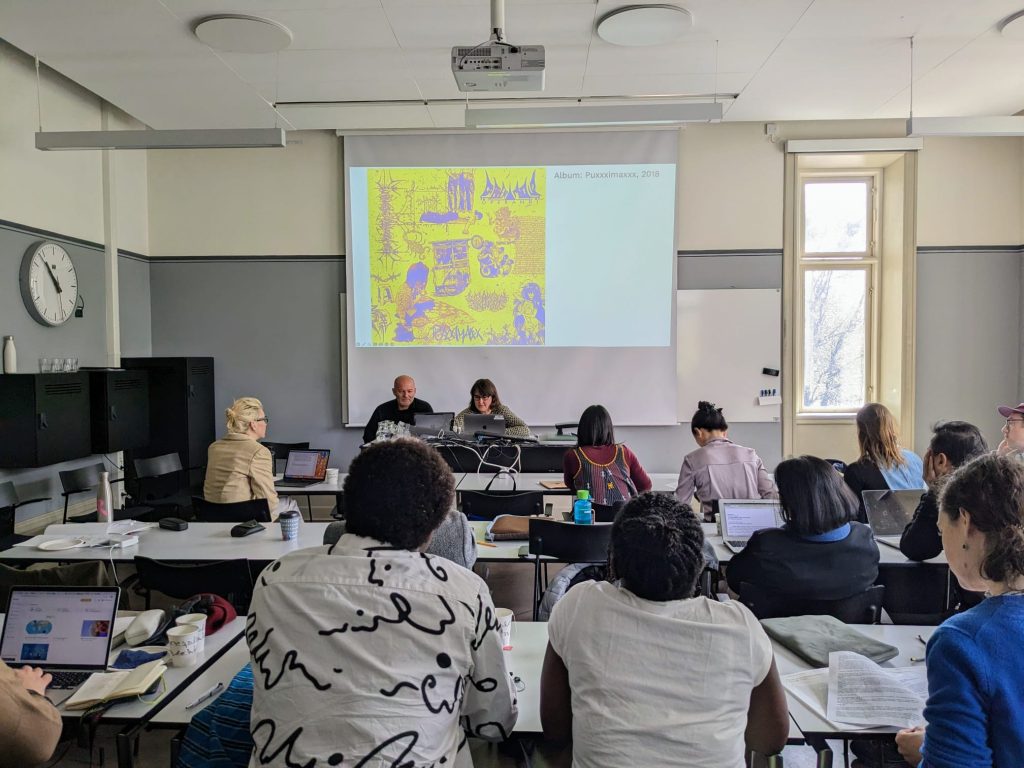
May 4 and 5 2023 we participated in and co-organised the conference “Music’s Institution and the (De)colonial” at Lund University. As a challenge to the theme of the conference we asked what to do, when collaborating interlocuters do not agree to word “decolonizing”? In our talk we focused on the work and performances of, as well as our talks and interviews with Gabber Modus Operandi, the Bali-based duo made up of Ican Harem and Aditya Surya Taruna, also known as Kasimyn. We began our talk by reflecting on Kasimyn’s explicit disavowal of the term “decolonial”:
“I fucking hate the word decolonizing. I mean, it is really flattering to have that discussion but to suggest that we are now the the real gabber, is another thing. This is not where we want to go.”
Kas, online interview, June 2020
In response to Kasimyn’s warning that a decolonial aesthetics all too easily becomes its own form of essentialism or exoticism, we talked about our attempts to begin aesthetic music analysis with emic terms. A case in point here is “post-alay”, a term introduced to us by GMO. “Alay” is an Indonesian pop cultural term. The word is short for “anak layangan” or ”kite-flying kid” and refers to the village kids who fly home-made kites, their skin turning dark from being in the sun all day. The term began to be used in the 1990s to refer to the cheesy or over-the-top and vulgar aesthetics associated with village youths who have poured in Indonesian cities in the millions over the previous three decades. Penniless, these kids would wear old clothes, use second-hand phones, and cultivate their own style of village-taste that was perceived as cheesy or vulgar by both the urban middle-class and the high-brow cosmopolitan elite.
Alay kids developed their language and aesthetics and today alay is for a growing number of Indonesian youths a badge of honour: it means “getting-by-with-what-you-have”; it means changing fashion, language, politics with the “fuck-you attitude of youth”. An alay aesthetics runs through GMOs music, performances, and visual representations – GMO refers to this aesthetic as “post-alay”.

We decided early on to begin our own analysis by learning analytically to rethink what aesthetics and taste might if studied through the term post-alay. We find the term alluring analytically because it speaks so well with what we have come to think of as “transposition”: the reworking of an aesthetic phenomenon into a different key. Alay and transposition are analytical synonyms that seek to trace the aesthetic nuances, histories and imaginaries in the work and globalization of Indonesian electronic music projects. Alay, after all, is an aesthetic transposition that turns village clothes into high fashion, and transposes what is vulgar and cheesy into something that might be urban- cool, in a self-mocking fashion.
We like the term transposition as a synonym for the term alay, because it, too, has multiple roots.
In conventional music theory, the term transposition refers to the notation or performance of music in a different pitch. But its range of meanings is much more comprehensive. In biology, transposition refers to horizontal gene transferal. In chess, it refers to the varying moves that will get you to the same position. And in magic, transposition refers to the sleight -of-hand through which a performer switches one object for another.
Horizontal transfers, pitch shift, alternative moves and sleight-out-handroots are all critical, we think, to understanding the way aesthetics travels in a digital age.
We are inspired by these multiple meanings to suggest transposition as the movements of assemblages of aesthetics and cosmology across space and context. We use it to think about what might once have been called aesthetic globalization. Transposition allows for a globalization that is not merely secular and historically linear but also entails the possibility of trancing and possession as well as imaginary pasts. Trance – understood both as a global dance genre and a form of possession in Javanese villages – is key to GMOs music and to its ability to be transposed into very different settings from CTM in Berlin to a small club in Denpasar. Transposition, as we have to understand, is in the music of GMO also potentially a trance-position: the possibility of trance-possession.

The conference “Music’s Institution and the (De)colonial” at Lund University hosted speakers from every continent on Earth except the Antarctic. All presentations and discussions contributed to the overall theme, and provided broad insight into how contemporary scholars from around the world deal with issues of colonialism and practices of decolonizing when (re)writing music history. Many hesitated to use the term “decolonial” uncritically, and presenting it with ambiguity. Others thought it made unequivocal sense in their working contexts, and stressed it along issues such as repatriation of archives, democratisation of academia, and co-authorships. (De)colonial music histories, we learnt, are not homogeneous.
